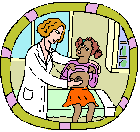By the end of this lesson you should be able to:
- identify a number of development indicators (health indicators like life expectancy, sanitation, medicines, infant mortality, doctor/patient ratio)
- categorise a number of facts which divide rich and poor countries
- make decisions about countries based upon these facts
 As we saw in our last session, the world can be divided into 2 parts: the rich north and the poor south. As we saw in our last session, the world can be divided into 2 parts: the rich north and the poor south.
There are many problems facing the countries of the Poor South. We regularly see pictures of the Poor South on TV and in newspapers. Many of the people living in these countries are less well off than we are. They are homeless, experience health problems, have little food and are poorly educated, and sometimes also affected by war.
But not everyone who lives in the Poor South is poor. Some people live in comfortable houses, wear good clothes and eat good food. Some countries in the Middle East and Asia have their populations split into the very rich and the very poor. Other areas such as Africa have almost total poverty.
 PROBLEM 1: HEALTH PROBLEM 1: HEALTH
Most people living in the developing world have very poor health. Life expectancy provides us with information about the health of a country. In Catalonia we have El Servei Català de Salut, which looks after our health. In the United Kingdom they have the National Health Service. As a result people in Catalunya or UK can expect to live 75 years on average, whereas countries like Sudan have a life expectancy of 53 years.
WHY DO PEOPLE IN DEVELOPING COUNTRIES HAVE POOR HEALTH?
Poor Sanitation: 2.9 billion people do not have safe sanitation facilities
No doctors: there is a shortage of doctors and nurses
No free medicines: people must pay for their medicines
No free health care: people must pay to see a doctor
EXERCISE 1
Now complete this table:
There are ..................................... main reasons why people in developing countries have poor health. One is that there are poor ..................................................... facilities. For example, .............................................. billion people do not have things like clean drinking water. A second reason is that there is a shortage of ........................................ and nurses. Also, there is no .......................... health care as people have to ............................................ for their medicines.
|
EXERCISE 2
Compare the two countries in the table below very carefully and state which of the two countries is the healthiest. You have to use full sentences and provide evidence by using the statistics in the table. You should start saying:
I think …………………………………. is the healthiest country because the table shows that people there live ............................... years, whereas in………………….people live………………………..
United Kingdom |
|
SUDAN
|
75 years |
Life Expectancy |
52 years |
7 per 1000 babies born |
Infant Mortality
(How many babies die per 1000 born) |
107 per 1000 babies born |
1 Doctor: 710 patients |
Doctor Patient Ratio
(How many patients a doctor looks after) |
1 doctor: 11,110 patients |
|





